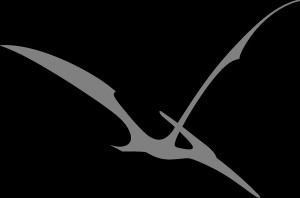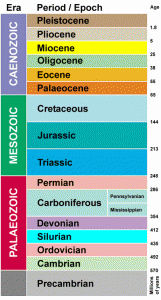History of a Fossil
The word Fossil can be defined as ‘The remains or trace evidence of prehistoric life’. The study of fossils is called palaeontology. Fossils can be as tiny as a seed or as huge as the skeleton of a giant dinosaur, they can be the actual remains of a once living thing, such as bones or even traces of past events such as dinosaur footprints.
Fossils are evidence of ancient life forms or ancient habitats which have been preserved by natural processes.
For animal or plant remains to have become ‘fossilised ‘, they must go through a certain process that preserves them for millions of years after they have died.
Geologists can tell the age of a fossil through a variety of radiometric dating techniques. The breakdown of radioactive isotopes of certain elements, such as carbon, uranium and potassium takes place at a known rate, so the age of a rock or mineral containing these isotopes can be calculated.
Fossil
1 The remains or impression of a prehistoric plant or animal embedded in rock and preserved in petrified form
How is a Fossil formed?
Fossilisation only happens in the rarest of cases, when a plant or animal dies in the right circumstances.
Even when buried under mud or soil, decay still takes place, though lack of oxygen does slow it down. If a skeleton is dug up at this stage, it will still be made of bone. Remains like these that haven’t truly fossilised yet are sometimes called ‘sub-fossils’.
As more time passes, sub-fossils become buried deeper and deeper. What was mud or sand becomes compressed on its way to becoming rock.
Chemicals and minerals percolate through the sediment and the original bone or shell gradually recrystallizes.
In other cases, minerals from the rocks gradually impregnate the bone, shell or wood, changing its chemical composition and making it capable of surviving for as long as – or sometimes longer than – the rock enclosing it. In cases where the original has dissolved away, the minerals can gradually fill the hollow to create a natural cast of the original. Sometimes a fossil doesn’t contain anything of the original creature except its shape. Eventually the rock enclosing a fossil is eroded away, and the fossil is revealed near the surface.
At this point the archaeologists will excavate it before the elements reduce it to silt, sand or mud.
Fossil Timeline
Fossils, by definition, are the remains or traces of organisms that lived at least 10,000 years ago. This date marks the end of the Cenozoic Era and the Pleistocene Period on the geologic time scale. Paleontologists consider materials younger than 10,000 years ago as ‘recent’.


